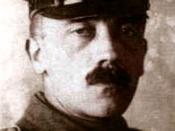In any artistic work, aesthetic style is a crucial aid to the viewer's understanding of the piece as a whole. Art Spiegelman's remarkable publication Maus breaks the conventional barriers of the past between comics and what were then considered to be serious novels. As a graphic novel about a horrific atrocity, Maus is the first work of its kind. Through the style of his drawings, Spiegelman is able to use illustration to aid in the telling of a story. Each individually crafted panel is detailed enough to be significant alone; together, they create a rich tapestry of images which portray a powerful story without compromising the work's literary integrity. Page 87 of Maus is an ideal example of Spiegelman's combination of thoughtful detail and underlying meaning in his drawings.
In panels 2, 3, 6 and 7 of page 87, Vladek and Artie are only shown as silhouettes. This might be taken to represent a connection with Vladek's past.
As Adolf Hitler is quoted to have said, "The Jews are undoubtedly a race, but they are not human," Jews were not viewed as worthwhile individuals. As the camps and gas chambers filled, each Jew became only a number, if even that. As the Jews were faceless then, Vladek is depicted as being faceless in the present.
Yet, it is noteworthy that Vladek's glasses are still visible against his dark silhouette. Glasses stereotypically represent a person's thought and intellect, and in these panels, spectacles imply a hint of Vladek's human aptitude. The contrast between the glasses and the silhouette is an ironic detail beyond what the initial glance might discern. Thoughtful details like these that appear throughout Maus are significant in their ability to lend a sense of humanity to an inhumanly cruel tale. Almost six million Jews were massacred during...


